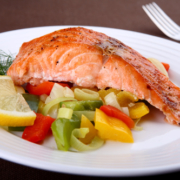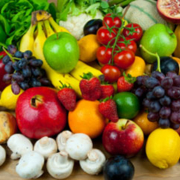Healthy Blueberry Muffins
The smell of fresh blueberry muffins in the air. Brings a lot of attention to the kitchen. It can be a challenge to bake healthy snacks that’s not packed full of sugar and fat.
Meg’s Healthy Blueberry Muffins recipe substitutes some common ingredients without loosing any of the flavour. Now that’s something everyone can enjoy!
Traditional blueberry muffins recipe contains:
- 2 cups white flour
- ½ cup white sugar
- 1/3c. Vegetable oil
- ½ c. blueberries
- baking powder 2 tsp.
- 1 egg
- 1 c. milk
Meg’s Healthy Blueberry Muffins Recipe:
- 2 cups white flour – cut white flour in half and add a whole
grain/flour such as whole wheat, oatmeal, barley, spelt, brown
rice, quinoa flours (or a combination of) =
*Use 1 c. white and 1c. whole grain in recipe
*might need a bit of extra liquid
*adds fiber and nutrients
- ½ cup white sugar – decrease to ¼ – ⅓ c.
- 1/3c. Vegetable oil – 1/4c.(4 T) Oil is ample. Can add ¼ c. apple sauce or grated apple to make up difference, add moisture due to whole grain addition, and for sweetness given less sugar. Could go as low as 2 T oil and add more apple
- ½ c. blueberries – can increase to 1 cup for more moisture, sweetness, nutrients, fiber
- baking powder 2 tsp.
- Also contains 1 egg and 1 c. milk all good
- Extra flavor – add 1 T lemon or orange rind or combo and enjoy some bioflavanoids while your at it 🙂
Baking Instructions:
- Preheat oven to 400 degrees F (205 degrees C). Line a 12-cup muffin tin with paper liners.
- In a large bowl, stir together milk, egg, and vegetable oil, and oil substitute.
- Add flour, flour substitute, baking powder, sugar, and blueberries; gently mix the batter with only a few strokes.
- Add your own special touch
- Spoon batter into cups.
- Bake for 20 minutes. Serve hot.
We all know that it may be often difficult to stop at one muffin. Meg’s Healthy Blueberry Muffins recipe is a wonderful way to give your family a healthy snack.
Managing nutritional needs may seem complicated with all of the information out there. What types of food? How should our food be prepared? Having a nutritional coach to help find answers that best meets our individual needs may be the answer.
To learn more about Meg’s nutritonal coaching services click here. We hope you enjoy this recipe for yourself, family and friends.
Check Out This Video Of Meg’s Blueberry Muffin Recipe









